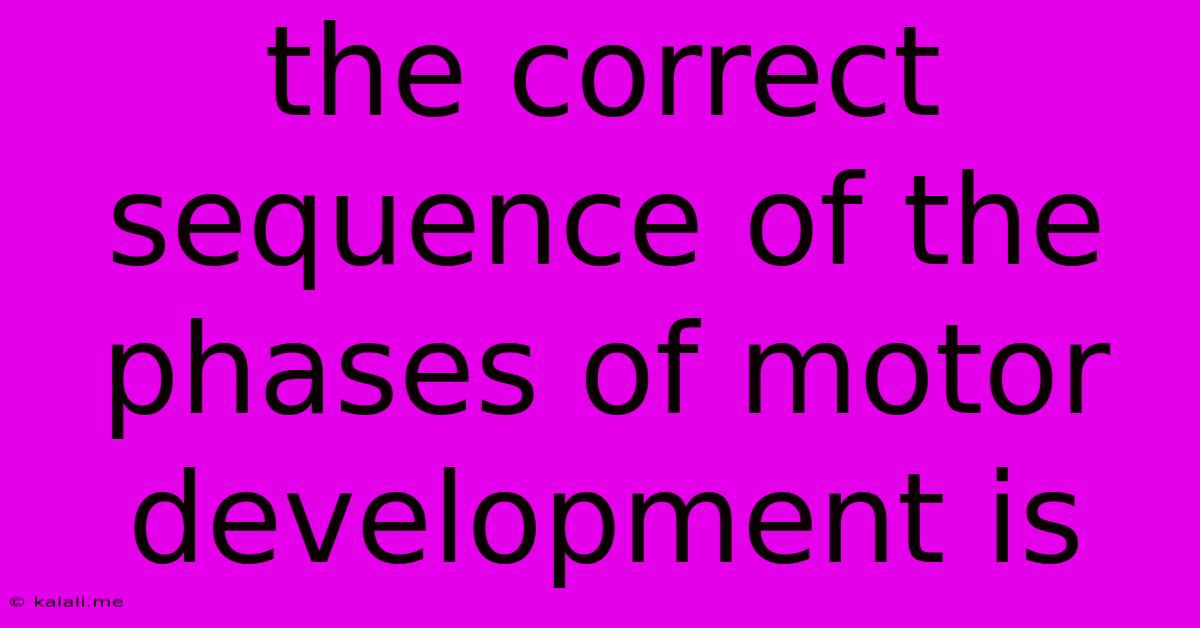The Correct Sequence Of The Phases Of Motor Development Is
Kalali
Jun 15, 2025 · 3 min read

Table of Contents
The Correct Sequence of Motor Development Phases: A Comprehensive Guide
Meta Description: Understanding the typical sequence of motor development phases in children is crucial for parents and caregivers. This guide details the key milestones, from infancy to childhood, highlighting the progression of gross and fine motor skills. Learn about age-appropriate expectations and when to seek professional guidance.
Motor development, the progression of a child's ability to control their body and move, is a fascinating and complex process. While individual timelines vary, a general sequence of phases characterizes this journey. Understanding this typical progression helps parents, caregivers, and educators identify developmental milestones and potential areas needing attention. This guide outlines the key phases and associated skills, offering a comprehensive overview of motor development.
Phase 1: Infancy (0-12 Months) – Reflexes and Early Movement
This initial phase is dominated by reflexes. Newborns exhibit instinctive movements like the rooting reflex (turning towards a touch on the cheek) and the grasp reflex. These reflexes gradually fade as voluntary control emerges. Significant milestones during this period include:
- Head Control: Lifting the head while lying on their stomach (typically around 2-3 months).
- Rolling Over: Transitioning from stomach to back and vice versa (usually between 4-6 months).
- Sitting: Sitting unsupported (around 6-8 months).
- Crawling: Moving on hands and knees (around 7-10 months).
- Pulling to Stand: Pulling themselves up to a standing position using furniture (around 8-12 months).
- Early Fine Motor Skills: Reaching for objects, grasping, and bringing objects to their mouth.
Phase 2: Toddlerhood (12-36 Months) – Walking and Enhanced Coordination
Toddlerhood marks a significant leap in gross motor skills. The emphasis shifts from reflexes to purposeful movement. Key advancements include:
- Walking: Independent walking (typically between 9-15 months).
- Running: Running, though initially unsteady (around 18-24 months).
- Climbing: Climbing stairs (with assistance initially, then independently).
- Jumping: Jumping in place (around 24-30 months).
- Improved Fine Motor Skills: Scribbling, stacking blocks, turning pages in a book, and developing hand-eye coordination.
Phase 3: Preschool Years (3-5 Years) – Refining Motor Skills
Preschoolers refine their motor skills, demonstrating increased precision and coordination. This phase focuses on improving both gross and fine motor abilities:
- Improved Balance and Coordination: Riding a tricycle, hopping on one foot, catching a ball.
- Advanced Fine Motor Skills: Drawing shapes, cutting with scissors, buttoning clothes, writing simple letters and numbers.
- Enhanced Hand-Eye Coordination: Playing games requiring hand-eye coordination, such as throwing and catching.
Phase 4: Early Childhood (5-7 Years) – Advanced Motor Skills and Physical Activities
Children in early childhood significantly improve their motor skills, allowing them to participate in more complex physical activities:
- Increased Agility and Strength: Running faster, jumping further, and improved endurance.
- Complex Fine Motor Skills: Writing fluently, drawing detailed pictures, using tools like a hammer and screwdriver.
- Sport Participation: Developing skills for team sports and recreational activities.
Factors Influencing Motor Development
Several factors can influence the rate and sequence of motor development. These include:
- Genetics: Inherited traits contribute to individual variations in physical capabilities.
- Environment: Opportunities for play and exploration significantly impact motor skill development.
- Nutrition: Adequate nutrition supports physical growth and development.
- Health: Illnesses or injuries can temporarily or permanently affect motor development.
When to Seek Professional Guidance
While variations exist, significant delays or deviations from the typical sequence warrant professional assessment. Consult a pediatrician or developmental specialist if you have concerns about your child's motor development. Early intervention can significantly improve outcomes.
This guide provides a general overview of the sequence of motor development phases. Remember, each child develops at their own pace, and seeking professional help if needed is crucial for ensuring optimal development. Observe your child's progress, celebrate their achievements, and provide a supportive and stimulating environment for their growth.
Latest Posts
Latest Posts
-
Which Of The Following Does Not Conduct Nitrogen Fixation
Jun 15, 2025
-
Anything That Occupies Space And Has A Mass
Jun 15, 2025
-
An Electromagnet Is A With A Core
Jun 15, 2025
-
How Is An Observation Different From An Inference
Jun 15, 2025
-
Unit Of Pressure In Cgs System
Jun 15, 2025
Related Post
Thank you for visiting our website which covers about The Correct Sequence Of The Phases Of Motor Development Is . We hope the information provided has been useful to you. Feel free to contact us if you have any questions or need further assistance. See you next time and don't miss to bookmark.